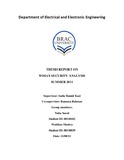Wimax security analysis

View/
Date
2011-04-28Publisher
Department of Electrical and Electronic EngineeringMetadata
Show full item recordAbstract
Worldwide Interoperability for Microwave Access (WiMAX) is a wireless metropolitan area network (WMAN) communications technology using the IEEE 802.16 standard. The original purpose of IEEE 802.16 technologies was to provide last-mile broadband wireless access as an alternative to cable, digital subscriber line (DSL). Developments in the IEEE 802.16 standard shifted the technology’s focus toward a more cellular-like, mobile architecture to serve a broader market.
WiMAX network threats focus on compromising the radio links between WiMAX nodes. These radio links support both line-of-sight (LOS) and non-line-of-sight (NLOS) signal propagation. Links from LOS WiMAX systems are generally harder to attack than those from NLOS systems because an adversary would have to physically locate equipment between the transmitting nodes to compromise the confidentiality or integrity of the wireless link. WiMAX NLOS systems provide wireless coverage over large geographic regions, which expand the potential staging areas for both clients and adversaries. Like other wireless networking technologies, all WiMAX systems are susceptible to denial of service attacks, eavesdropping, man-in-the-middle attacks, message modification, and resource misappropriation.
In our report we are now going to explain the working technique of WiMAX and about the
related security threats. Then we are going to show some plans that we are going to fulfill in our Thesis semester to solve the security threats as much as possible.
